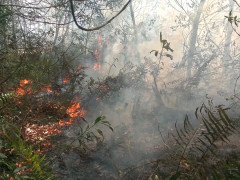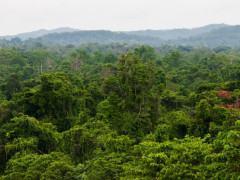Smog-covered Dumai
By Romes Irawan PutraVictims of Peatland Conversion: Indigenous People, Migrants, and Biodiversity

Mudji Isa, a migrant in West Kalimantan, tells the story of his life in the area during a time when peatlands were rampantly being converted into plantations. In the end, he realizes that the conversion of peatland into plantations only benefitted a select few. Meanwhile, it negatively impacted indigenous peoples, migrants, and the environment.
About the author: Mudji Isa migrated to West Kalimantan from Java with his family in 1993.
In 1993, my father moved our family from Magelang, Central Java to Sanggau, West Kalimantan. At that time, the government hoped the migration program would help equalize the population distribution and alleviate poverty. My father saw the transmigration program as a solution to the bleak economic situation in Magelang and a way to prevent his children from dropping out of school. There were two transmigration systems: the general program and the nucleus estate and smallholder program (Perkebunan Inti Rakyat, PIR). Our family participated in the PIR program. We lived in a settlement unit, where each family was given a house on half a hectare of land. Our residential unit was home to immigrants from East Nusa Tenggara, West Java, and Central Java, who lived side-by-side with the indigenous Dayak Mualang people. Meanwhile, the palm oil plantations were located around the settlement unit.
The government had two primary messages at that time. They told us migrant families that the land in Kalimantan consists of nutrient-poor peat soil, in which only hardy plants can be grown. Meanwhile, the government asked the indigenous people, who originally owned the forest, to give up their land to oil palm plantations. They were promised the same rights as migrants, which included, among other things, agricultural training. Despite this disparate messaging, every family – both migrant and indigenous – received half a hectare of land for residence and two hectares of oil palm plantation to work.
Under the PIR program, large oil palm plantations served as the nucleus of the estate, supporting the development of the surrounding smallholder plantations. The development of such plantation, from seedling to harvest, usually takes around five years. During that five-year-period, all the costs associated with land clearance, planting, maintenance, and fertilizer were borne by the nucleus oil palm firm. The firm was financed by the bank, using smallholders’ land certificates as a guarantee for the loan. Participants in the PIR transmigration program put in five years of labor and were compensated through a daily payment system, which was also financed by the bank. When the palm oil was ready, the farmers harvested it and sold it to the large firm at the nucleus of the estate. The proceeds were directly deducted from the farmers’ debt, and the company then used the profits to repay the bank.
When the debt was paid off, the farmer received the land title certificate. This was certainly difficult to achieve in only one harvest. Unfortunately, the land and oil palms were not always productive and thus needed periodic rejuvenation. This affected farmers’ ability to repay the bank promptly.
Oil palms are usually productive for 25–30 years. However, peatlands in Kalimantan can only be productive for roughly 20 years, after which the soil’s nutrients are depleted. After that, the land needs to be rejuvenated by felling old trees and planting new trees. During the rejuvenation, regulations prohibited replanting, so farmers were left without income and became dependent on the bank. This was an endless cycle that made it very difficult for farmers to get their land certificate. So, in 1998, my father decided to return to Java.
At that time, I did not understand what my father was thinking. I was a curious child and wanted to work in a palm oil factory. I prayed and prayed. In 2010, God answered my prayers. I got a job at a palm oil factory in Labuhan Batu, North Sumatra. That's where I came to understand what my father experienced. In essence, companies want Crude Palm Oil (CPO) for export. These companies are mostly from Europe and consider Indonesia’s sun-drenched, tropical climate ideal for oil palm plantations.
However, converting Indonesian land into oil palm plantations is complicated, as people live here and rely on this land for survival. So, the government created three systems to support the development of the oil palm industry while maintaining local livelihoods. The first system is the nucleus estate, in which plantation companies gain cultivation rights to develop plots of land into oil palm plantations. The second system is a cooperation between smallholder farmers and companies. The smallholders are granted a plot of land to plant oil palm, and then sell the harvest to local companies. In areas occupied by indigenous people, the third system of transmigration with the PIR program is offered.
Although the government claims that the conversion of peatland to oil palm plantations is an attempt to alleviate poverty through equitable development, this is not how it works in reality. In fact, the opposite happens.
Indigenous peoples such as the Dayak Mualang tribe lose their forests. Migrants are only employed indirectly and are unable to get out of the cycle of debt. Biodiversity is reduced as the heterogeneous crops previously grown in peatlands are replaced with homogeneous oil palms. These are all victims of the conversion of peatland. The only beneficiaries of these systems are businesspeople, who now control the natural lands of Indonesia.
Therefore, let's learn from the past, so as not to repeat the same mistakes in the present. We still have a chance to restore and protect peatlands for indigenous groups, migrants, and native wildlife.
[Disclaimer: The views expressed herein are the author’s and do not necessarily represent the views of Pantau Gambut.]



